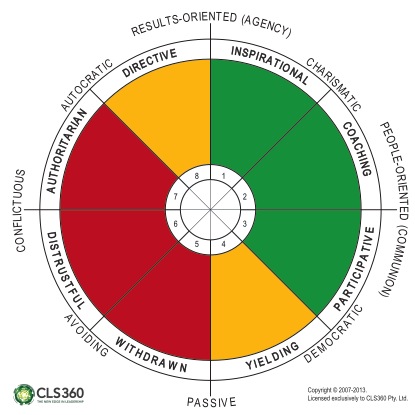Metamotives
The CLS360 has two metamotives:
1. The Agency or the ʻResults-Orientedʼ dimension positioned on the vertical or y-axis; and
2. The Communion or ʻPeople-Orientedʼ dimension positioned on the horizontal or x-axis.
 These two axes further divide the circumplex into four quadrants, which in turn are divided into octants with eight equally spaced scales in a circular structure around the circumplex, representing eight different leadership styles. The midpoint of each octant/style is 45° from the midpoint of its neighbouring octant/style.
These two axes further divide the circumplex into four quadrants, which in turn are divided into octants with eight equally spaced scales in a circular structure around the circumplex, representing eight different leadership styles. The midpoint of each octant/style is 45° from the midpoint of its neighbouring octant/style.
Starting at the positive pole (top) of the Agency axis and going clockwise:
- the upper-right Charismatic quadrant includes the Inspirational and Coaching leadership styles, which are characterised by behaviours high in Agency or results oriented (Inspirational) and Communion or people oriented (Coaching). Leaders using these styles are often described as being ‘assertive’;
- the lower-right Democratic quadrant includes the Participative and Yielding leadership styles, which are characterised by behaviours high in Communion (Participative) and behaviours relatively low in Agency (Yielding). Leaders using these styles are often described as being ‘adaptive’;
- the lower-left Avoiding quadrant includes the Withdrawn and Distrustful leadership styles, and is characterised by behaviours low in both Agency and Communion. Leaders using these styles are often described as being ‘passive’; and
- the upper-left Autocratic quadrant includes the Authoritarian and Directive leadership styles, and is characterised by behaviours very low in Communion and behaviours very high in Agency. Leaders using these styles are often described as being ‘aggressive.’
The styles on opposite poles of the axes are negatively correlated; styles on orthogonal (right angle) poles are unrelated, while styles next to each other are closely related. Each style differs in its degree of Agency and Communion; therefore, all forms of these eight leadership interpersonal behaviour styles can be viewed as a specific blend of these two metamotives, producing a gradual continuum of behaviour.